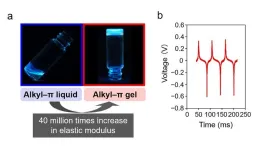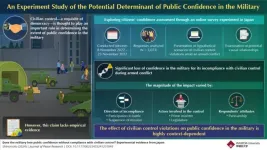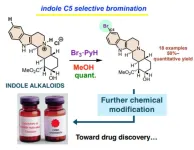(Press-News.org) New Haven, Conn. — Patients with pancreatic cancer who received chemotherapy both before and after surgery experienced longer survival rates than would be expected from surgery followed by chemotherapy, according to a new study from researchers at Yale Cancer Center (YCC) and Yale School of Medicine.
The study, published June 20 in JAMA Oncology, included patients with pancreatic ductal adenocarcinoma (PDAC), which accounts for 90% of pancreatic cancers. An aggressive cancer with a high mortality rate, PDAC is predicted to become the second leading cause of cancer-related deaths in the U.S. by 2030.
The findings, say the researchers, are encouraging for the 15 to 20% of pancreatic cancer patients whose tumors are operable.
The single-arm (only one treatment type or regimen) Phase II trial evaluated a modified form of the chemotherapy treatment FOLFIRINOX (a combination treatment consisting of leucovorin calcium, fluorouracil, irinotecan hydrochloride, and oxaliplatin approved in 2011 as a first-line treatment for patients with metastatic pancreatic cancer).
Patients in the trial received six cycles of the modified FOLFIRINOX before surgery, followed by an additional six cycles of the chemotherapy treatment after surgery. The modified regimen consisted of slightly lower doses of FOLFIRINOX to improve tolerability, which was previously shown in a 2016 publication not to impact outcomes negatively.
Of the 46 patients who started the modified treatment, 37 completed all six cycles of chemotherapy before surgery and 27 had successful tumor removal operations. For all enrolled patients, the 12-month progression-free survival rate — meaning the disease did not worsen — was 67%, indicating significant progress in controlling the disease. Furthermore, 59% of all patients lived at least two years after completing the full chemotherapy treatment plan and surgery.
The study was the first of its kind for patients with PDAC when senior author and YCC member Dr. Jill Lacy started it in 2014. The study goal had been a 12-month progression-free survival rate of at least 50% of patients.
“When the study launched, even with operable pancreatic cancers, 90% of patients were still relapsing and dying from their cancer eventually,” said Dr. Michael Cecchini, the first author of the study and the co-director of the colorectal program at the Center for Gastrointestinal Cancers at Smilow Cancer Hospital and YCC. “We sought to move chemotherapy up in their treatment regimen and give it before surgery to see if we could improve the outcome for our patients.”
The study used advanced techniques to monitor the progress of treatment, including analyzing circulating tumor DNA (ctDNA) and using the cancer biomarker keratin 17 to help predict outcomes. For example, patients with detectable ctDNA four weeks post-surgery had significantly worse progression-free survival than those who had no detectable ctDNA.
Cecchini said larger randomized clinical trials are needed to continue to investigate the role of FOLFIRINOX before surgery for patients with operable PDAC.
“I think even though there have been changes in standard of care for patients with this aggressive pancreatic cancer type, we have here very promising data to justify a larger study,” said Cecchini.
END
YALE NEWS: Chemotherapy before surgery benefits some patients with pancreatic cancer
2024-06-20
ELSE PRESS RELEASES FROM THIS DATE:
First conclusive evidence that a terrestrial leech species can jump
2024-06-20
A new study presents video evidence that at least one species of terrestrial leech can jump, behavior that scientists have debated for more than a century. Researchers from the American Museum of Natural History, Fordham University, and City University of New York (CUNY)’s Medgar Evers College published the footage and corresponding analysis today in the journal Biotropica.
“We believe this is the first convincing evidence that leeches can jump and do so with visible energy expenditure,” said lead author Mai Fahmy, a visiting scientist at the Museum and a postdoctoral researcher ...
Creation of a power-generating, gel electret-based device
2024-06-20
1. A team of researchers from NIMS, Hokkaido University and Meiji Pharmaceutical University has developed a gel electret capable of stably retaining a large electrostatic charge. The team then combined this gel with highly flexible electrodes to create a sensor capable of perceiving low-frequency vibrations (e.g., vibrations generated by human motion) and converting them into output voltage signals. This device may potentially be used as a wearable healthcare sensor.
2. Interest in the development of soft, lightweight, power-generating materials has been growing in recent years for use in soft electronics designed for various purposes, such as ...
How E. coli defends itself against antibiotics
2024-06-20
When E. coli detects damage to its genetic material, it sends out an SOS signal that alters activity inside the cells.
“The bacteria go into full emergency mode,” says PhD candidate Olaug Elisabeth Torheim Bergum at the Norwegian University of Science and Technology (NTNU).
Imagine that you have a very sore throat. You're sick, your throat hurts, and a visit to the doctor confirms that the pain is due to a bacterial infection. You get a prescription for antibiotics, which quickly sorts out your sore throat. You are pleased that the treatment ...
Mental health leaders to gather for international summit on suicide prevention
2024-06-20
DETROIT (June 20, 2024)— Mental health experts from across the globe will gather to share insights, best practices, and innovations for preventing suicide during the 5th Zero Suicide International Summit June 24-25 in Liverpool, England.
Named for the innovative, evidence-based suicide intervention model developed at Henry Ford Health, the Zero Suicide International Summit is presented by the Detroit-based healthcare system in partnership with Zero Suicide Alliance (ZSA) and The Kevin and Margaret Hines Foundation.
The Zero Suicide model was developed at Henry Ford Health in 2001. Within a year of implementing the ...
Can AI learn like us?
2024-06-20
It reads. It talks. It collates mountains of data and recommends business decisions. Today’s artificial intelligence might seem more human than ever. However, AI still has several critical shortcomings.
“As impressive as ChatGPT and all these current AI technologies are, in terms of interacting with the physical world, they’re still very limited. Even in things they do, like solve math problems and write essays, they take billions and billions of training examples before they can do them well, " explains Cold Spring Harbor Laboratory (CSHL) NeuroAI Scholar Kyle Daruwalla.
Daruwalla ...
Changing climate will make home feel like somewhere else
2024-06-20
Changing climate will make home feel like somewhere else
Interactive app shows how climate change will make places around the world feel like they are closer to the equator
FROSTBURG, MD (June 20, 2024)—The impacts of climate change are being felt all over the world, but how will it impact how your hometown feels? An interactive web application from the University of Maryland Center for Environmental Science allows users to search 40,581 places and 5,323 metro areas around the globe to match the expected future climate in each city with the current climate of another location, ...
Newly discovered dinosaur boasts big, blade-like horns
2024-06-20
What do you get when you cross Norse mythology with a 78-million-year-old ancestor to the Triceratops? Answer: Lokiceratops rangiformis, a plant-eating dinosaur with a very fancy set of horns.
The new dinosaur was identified and named by Colorado State University affiliate faculty member Joseph Sertich and University of Utah Professor Mark Loewen. The dinosaur’s name, announced today in the scientific journal PeerJ, translates roughly to “Loki’s horned face that looks like a caribou.”
Loewen and Sertich, co-lead authors of the PeerJ study, dubbed the new species Lokiceratops (lo-Kee-sare-a-tops) ...
Exploring the relationship between civilians and military organizations through an experiment in Japan
2024-06-20
In democracies where civilian control is followed, the power to make crucial decisions, like those of national security, is mainly exercised by elected officials, allowing the citizens who elect them to influence such decisions indirectly. This role can give people a sense of participation in matters of national importance, potentially associated with their political trust. The military, in such cases, advises and helps these elected leaders in serving the nation, rather than assuming leadership itself. A balance between civilians and military organizations is, therefore, crucial for any democracy to thrive, and it is pointed out that civilian control is a requisite of democracy.
Existing ...
A simple, fast, and versatile method for selective bromination of indole alkaloids
2024-06-20
Indolo[2,3-a]quinolizidine is a common structural motif in various natural products. Its molecular structure contains the indole ring, a functional group in tryptophan. Tryptophan, an essential amino acid, is required for the production and maintenance of our body’s proteins, muscles, enzymes, and neurotransmitters. Many natural products are derived from it. Over 3,000 monoterpene indole alkaloids (MTIAs), which are natural products consisting of indole rings, have been found in plants, and some of them have been used as medicines. For example, vinblastine has been used as an anticancer drug, and reserpine is used to treat high blood pressure.
The ...
Removal of ovaries before menopause associated with reduced white matter in brain
2024-06-20
WINSTON-SALEM, N.C. – June 20, 2024 – Women who have their ovaries removed before menopause, particularly before the age of 40, have reduced white matter integrity in multiple regions of the brain later in life. White matter refers to the nerve fibers that connect neurons in different areas of the brain.
The findings appear online today in Alzheimer’s & Dementia: The Journal of the Alzheimer’s Association.
“We know that having both ovaries removed before natural menopause causes abrupt endocrine dysfunction, which increases ...








